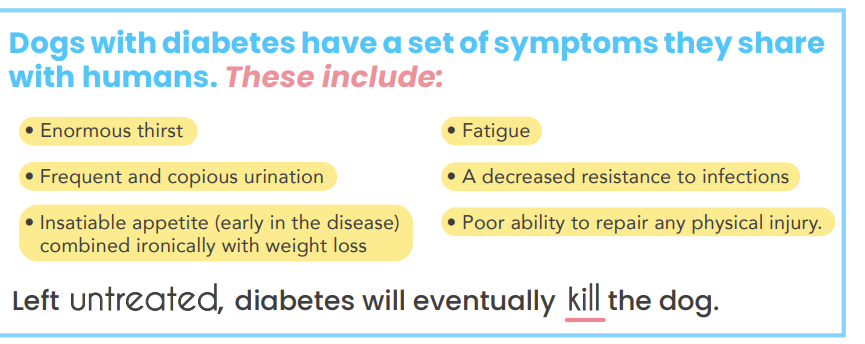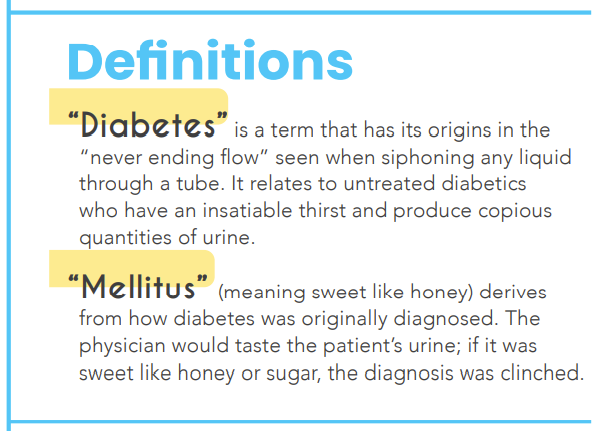Diet and diabetes in dogs – is there a connection?

Poor nutrition contributes to premature aging and degenerative conditions that can lead to the development of diabetes in dogs. Here’s why, and how an ancestral diet can help prevent and manage this common disease.
Our dogs are our “fur babies”. And much like human children, they can develop “sugar diabetes”, clinically known as Type I diabetes mellitus. This article looks at diabetes in dogs, and how diet plays a role in its development and management.
What causes canine diabetes?
Diabetes results from a problem with insulin, a hormone produced by the pancreas. Insulin is called the hormone of storage. It enables body cells to take nutrients out of the bloodstream to be “stored” or used to produce energy. In this role, insulin enables blood sugar to enter body cells where organelles called mitochondria “burn” sugar to produce energy. This biochemical process enables cells to survive, grow, repair and carry out their normal functions.
Fast fact: Type I diabetes develops when the pancreas loses its ability to produce insulin; Type II diabetes, also known as “adult onset diabetes”, occurs when insulin no longer functions properly.
So what causes a dog to lose his ability to produce insulin? Textbooks of veterinary medicine tell us that canine diabetes is “multifactorial” in origin, involving a range of issues that can damage the insulin-producing cells of the pancreas (the pancreatic beta cells). These issues include:
- Genetic predisposition to diabetes
- Pancreatic infections,
- Obesity, resulting in insulin resistance
- Pharmaceutical drug damage
- Autoimmune attack on the pancreatic beta cells
- Pancreatitis
- Insulin-antagonistic diseases, which involve the deregulation of hormones such as glucagon, adrenaline, cortisol and growth hormone — all of which antagonise the actions of insulin.
In many dogs, Type I diabetes results from an autoimmune attack on the pancreas. The body uses immune system to attack the pancreas and destroy the pancreatic beta cells.
What about diet?
Most veterinary textbooks ignore diet as a factor in canine diabetes. And yet incorrect diet lies behind each and every one of the health issues leading to diabetes! This brings us to an important area of understanding. The common feature in all the issues leading up to diabetes is that they involve bodily degeneration and premature aging. Poor diet results in premature aging, which in turn causes a range of health problems that can result in diabetes. This is particularly so when the dog has a genetic predisposition to diabetes.
From this understanding, what appears to be a complex condition with many different causes is in fact a disease with one common problem — the lifetime consumption of a faulty diet.
Fast fact: Poor nutrition produces premature aging.
Four questions to ask
If diet is such a vital factor in causing diabetes, there are four obvious questions we need to ask:
- Which dietary features result in one or more “diabetes-causing” factors or diseases?
- Which would prevent “diabetes-causing” factors or diseases?
- Which would best enable the management of diabetes, once it has occurred?
- Is there a diet that would enable the repair or restoration of insulin-producing cells in the pancreas?
The good news is that the answers to these questions are wonderfully straightforward. Animals fed a diet that closely match the type of diet eaten by their ancestors — their evolutionary program of nutrition, the diet their genes have evolved to require — are least likely to develop diabetes. Furthermore, this diet is not only the best for preventing diabetes, but is also best equipped to manage the disease once it has occurred. It is also the diet most likely to restore insulin production in the pancreas…if that is ever a possibility.

Carbohydrates are a major culprit
On the flip side, the type of diet most likely to result in diabetes has features that depart from the evolutionary ideal in a number of specific areas. And what is more, the more a lifetime dietary program departs from that ideal, the more likely it is that the disease issues leading to canine diabetes will occur.
The most damaging feature of a diet that predisposes a dog to diabetes is the use of soluble carbohydrates as the principal source of energy. This means any diet based on grains, or carbohydrate-rich foods such as potatoes, is more likely to produce diabetes, as opposed to a diet where fat and proteins supply the bulk of dietary energy.
It works this way. Carbohydrate-heavy diets cause a rapid rise in blood sugar. When these foods are consumed over a lifetime, the resulting continued elevation in blood sugar has a number of unfortunate consequences, as follows:
- Constantly high blood glucose results in the need for constantly high insulin production. This places an excessive strain on the insulin-producing cells in the pancreas, which can result — ultimately — in the exhaustion and eventual death of the pancreatic beta cells.
- Constantly high blood sugar results in the production of damaging molecules called “advanced glycosylated end products” or AGEs. These AGEs accelerate the aging process throughout the body, including damage to the immune system.
- Constantly high blood sugar together with resulting high blood insulin result in massive levels of bodily inflammation. And inflammation is the major factor driving the whole range of degenerative disease processes that lie behind aging and the development of diabetes.
Additional dietary problems
Further damaging dietary features also contribute to diabetes:
- Cooking both destroys some nutrients and makes others unavailable.
- Excessive levels of Omega-6 oils and low levels of Omega-3s drive inflammation
- A lack of protective nutrients such as antioxidants can
- Poor quality proteins result in a lack of immune competence.
Fast fact: Poor quality ingredients, high levels of soluble carbohydrates, and cooking that destroys nutrients are the most damaging dietary factors when it comes to development of diabetes.
Evolutionary program of nutrition
From my perspective as a veterinarian with over 40 years of experience treating dogs with diabetes, the diet that best prevents, treats and manages this disease — and the one most likely to restore health to the pancreas — is the diet dogs evolved to require.
This evolutionary program of nutrition is, in principle, very simple to prepare and feed. It goes under a number of names such as the “BARF” (Bones and Raw Food) diet, the “raw whole food” diet and so on. This diet uses fats and proteins as its principal energy sources and is based on the use of raw meaty bones, together with organ meats, vegetables and fruit. To this is added a range of other healthy foods such as eggs, fermented foods, kelp and so on. You can find more details about this nutritional program at drianbillinghurst.com.
Diabetes is common in dogs. However, a nutritional approach that avoids poor quality ingredients and soluble carbs, and that most closely mimics the ancestral diet our canines evolved to eat, can help prevent the inflammation and other degenerative health issues that lead to the development of this disease.




